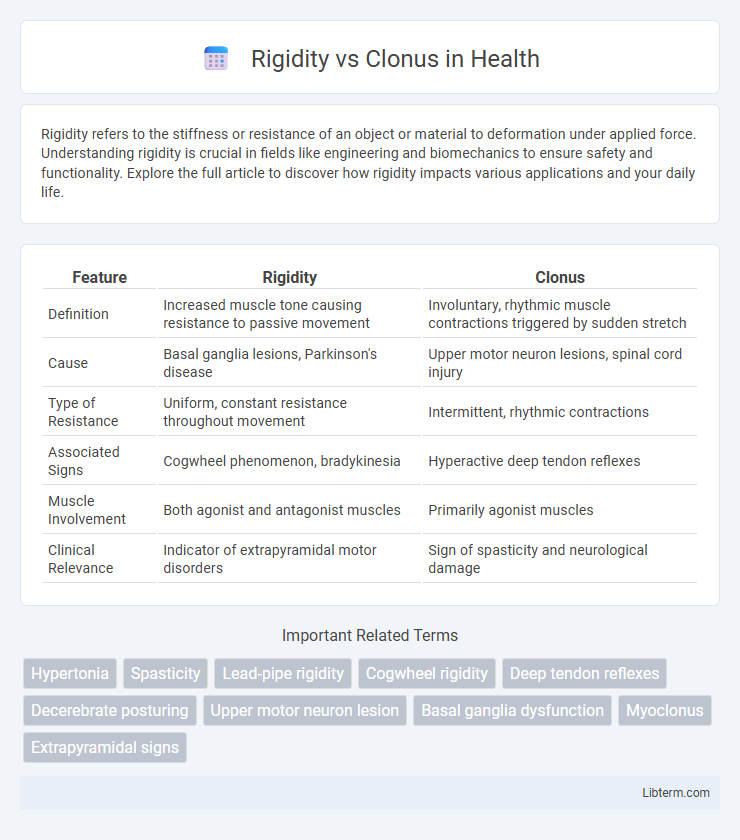Rigidity refers to the stiffness or resistance of an object or material to deformation under applied force. Understanding rigidity is crucial in fields like engineering and biomechanics to ensure safety and functionality. Explore the full article to discover how rigidity impacts various applications and your daily life.
Table of Comparison
| Feature | Rigidity | Clonus |
|---|---|---|
| Definition | Increased muscle tone causing resistance to passive movement | Involuntary, rhythmic muscle contractions triggered by sudden stretch |
| Cause | Basal ganglia lesions, Parkinson's disease | Upper motor neuron lesions, spinal cord injury |
| Type of Resistance | Uniform, constant resistance throughout movement | Intermittent, rhythmic contractions |
| Associated Signs | Cogwheel phenomenon, bradykinesia | Hyperactive deep tendon reflexes |
| Muscle Involvement | Both agonist and antagonist muscles | Primarily agonist muscles |
| Clinical Relevance | Indicator of extrapyramidal motor disorders | Sign of spasticity and neurological damage |
Understanding Rigidity and Clonus: Key Differences
Rigidity is characterized by a constant resistance to passive movement throughout the entire range of motion, often associated with conditions like Parkinson's disease, while clonus presents as repetitive, rhythmic muscle contractions triggered by sudden stretching of a muscle, commonly seen in upper motor neuron lesions such as multiple sclerosis or stroke. Rigidity affects both flexor and extensor muscles, producing a uniform stiffness, whereas clonus is an involuntary reflex causing oscillating movements and is indicative of hyperactive stretch reflexes. Distinguishing these neuromuscular signs is crucial for diagnosing and managing neurological disorders with precision.
Defining Rigidity: Causes and Characteristics
Rigidity is a neurological symptom characterized by increased muscle tone resulting in resistance to passive movement, commonly seen in Parkinson's disease due to basal ganglia dysfunction. It manifests as uniform stiffness throughout the range of motion, differing from the rhythmic muscle contractions of clonus which indicate upper motor neuron lesions. Causes include neurodegenerative disorders, drug-induced conditions, and metabolic imbalances affecting motor control pathways.
Clonus Explained: Features and Triggers
Clonus is a neurological condition characterized by involuntary, rhythmic muscle contractions and relaxations, often triggered by sudden muscle stretching or reflex testing. This repetitive muscle activity typically occurs in patients with upper motor neuron lesions, such as those seen in multiple sclerosis, stroke, or spinal cord injury. Distinguishing clonus from rigidity, which involves continuous muscle stiffness without rhythmic movement, is crucial for accurate diagnosis and appropriate management of underlying neurological disorders.
Pathophysiology of Rigidity and Clonus
Rigidity results from increased muscle tone due to dysfunction of the basal ganglia, particularly involving disrupted inhibitory pathways in the extrapyramidal system, leading to continuous involuntary muscle contraction. Clonus is characterized by rhythmic, involuntary muscle contractions caused by hyperexcitability of the stretch reflex arc, often linked to upper motor neuron lesions affecting inhibitory modulation at the spinal cord level. Both conditions reflect abnormal neural control of muscle tone but arise from distinct pathophysiological mechanisms involving central nervous system pathways.
Clinical Presentation: How Rigidity and Clonus Manifest
Rigidity presents as a continuous resistance to passive movement, often described as lead-pipe stiffness, commonly seen in Parkinson's disease, affecting both flexor and extensor muscles uniformly. Clonus is characterized by rhythmic, involuntary muscle contractions triggered by sudden stretch, frequently observed in upper motor neuron lesions such as multiple sclerosis or stroke. Clinically, rigidity leads to sustained muscle stiffness, while clonus manifests as repetitive jerking motions, providing critical clues for neurological assessment.
Neurological Conditions Associated with Rigidity
Rigidity is commonly associated with neurological conditions such as Parkinson's disease, characterized by increased muscle tone and resistance to passive movement throughout the range of motion. Unlike clonus, which involves rhythmic muscle contractions often seen in upper motor neuron lesions like multiple sclerosis or stroke, rigidity presents as a consistent stiffness without repetitive jerks. Understanding the distinction between rigidity and clonus aids in diagnosing disorders involving basal ganglia dysfunction and spinal cord pathology.
Disorders Commonly Linked to Clonus
Clonus is frequently associated with neurological disorders including multiple sclerosis, stroke, and spinal cord injury. This involuntary, rhythmic muscle contraction contrasts with rigidity, which is characterized by sustained muscle stiffness often seen in Parkinson's disease. Identifying clonus helps clinicians diagnose and differentiate these central nervous system conditions for targeted treatment.
Diagnostic Approaches: Rigidity vs Clonus
Diagnostic approaches for rigidity focus on assessing uniform resistance to passive movement, often present in conditions like Parkinson's disease, through clinical examination and electromyography (EMG) to detect constant muscle hypertonia. Clonus diagnosis involves eliciting rhythmic, involuntary muscle contractions using rapid dorsiflexion of the ankle or wrist, with neurologic exams highlighting hyperactive reflexes commonly linked to upper motor neuron lesions. Advanced techniques such as motion analysis and nerve conduction studies further differentiate rigidity from clonus by quantifying muscle response patterns and neural excitability.
Treatment Strategies for Rigidity and Clonus
Treatment strategies for rigidity often involve the use of dopaminergic medications such as levodopa and dopamine agonists to alleviate muscle stiffness in Parkinson's disease. Clonus management typically includes muscle relaxants like baclofen or benzodiazepines to reduce involuntary rhythmic contractions, alongside physical therapy aimed at improving muscle control and flexibility. Both conditions may benefit from tailored rehabilitation exercises and neuromodulation techniques to optimize motor function and patient mobility.
Prognosis and Patient Outcomes: A Comparative Overview
Rigidity, commonly seen in Parkinson's disease, often indicates a progressive neurodegenerative process with gradual motor decline, impacting long-term patient outcomes negatively. Clonus, frequently associated with upper motor neuron lesions, may suggest acute or chronic neurological injury, with prognosis varying based on the underlying cause and timely intervention. Early diagnosis and targeted treatments significantly influence recovery and functional independence in both conditions.
Rigidity Infographic

 libterm.com
libterm.com